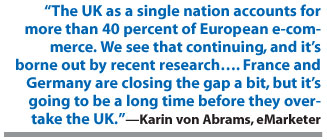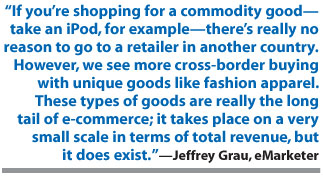June 2008 - Making Sense of European E-commerce

eMarketer’s Jeffrey Grau and Karin von Abrams
shed light on the fascinatingly disparate markets
that make up Europe’s online economy.
By Tom Dellner
Any analysis of European e-commerce is bound to be frustratingly complex. As with all online economies, it’s a moving target: new sites and commerce-enabling technologies are introduced on seemingly a daily basis. Additionally-and even more significant-Europe is anything but a homogenous online market. Differences in technological infrastructure, financial systems and social and business cultures abound, making each nation’s
e-commerce economy unique.
To sort through this complexity, Electronic Retailer sat down with two of the leading experts in the field, eMarketer’s Jeffrey Grau and Karin von Abrams, for an exclusive interview.
Electronic Retailer: To what extent do the UK,
Germany and France dominate the European
e-commerce landscape?
Karin von Abrams: The UK as a single nation accounts for more than 40 percent of European e-commerce. We see that continuing, and it’s borne out by recent research. The UK’s e-commerce sales volume is more than
twice that of France at more than 56 billion Euros. It’s far and away the highest in the region. France and Germany are closing the gap a bit, but it’s going to be a long time before they overtake the UK.
Jeffrey Grau: We’ve estimated total marketshare; the bookends for the forecast period were 2006 and 2011. For 2006, we projected that the UK accounted for 42.1 percent of European e-commerce, with Germany at 20.4 percent and France at 9.4 percent. In 2011, the “Big Three” as a whole will decrease (we estimate the UK at 38.3 percent, Germany at 19.6 percent and France at 10.3 percent). The UK and Germany are giving up a little share, but that has nothing to do with the health of the markets. It’s more to do with other countries-France and the rest of Europe
(particularly the Netherlands, Italy and Spain)-picking up momentum, and to a smaller, but growing extent, Eastern Europe.
ER: What accounts for the Big Three’s dominance?
JG: I think the factors are very similar to those we see in other robust e-commerce economies throughout the world: the countries’ IT infrastructure, PC penetration, broadband usage, financial systems (e.g., how many consumers use credit cards) and even the health of the general economy-whether the middle class is thriving. Business practices are a part of it, too. For instance, in Spain the custom of doing business face to face might be more ingrained than in other parts of Europe, which may slow Spanish e-commerce in certain product categories. It’s a combination of all these
factors.
 KVA: The UK has been a very vibrant online market-apart from the e-commerce dimension-for quite a long time. It’s historically led Europe in a number of important areas, such as thenumber of users, broadband penetration, etc. Also, there’s a history of buying through mail-order catalogs, which makes for an easy transition to e-commerce. Also, there’s quite a high credit card penetration, as Jeff has pointed out. So e-commerce retailers have been able to benefit from all these factors for quite a long time: solid infrastructure, comfort with long-distance buying, ease of payment and others.
KVA: The UK has been a very vibrant online market-apart from the e-commerce dimension-for quite a long time. It’s historically led Europe in a number of important areas, such as thenumber of users, broadband penetration, etc. Also, there’s a history of buying through mail-order catalogs, which makes for an easy transition to e-commerce. Also, there’s quite a high credit card penetration, as Jeff has pointed out. So e-commerce retailers have been able to benefit from all these factors for quite a long time: solid infrastructure, comfort with long-distance buying, ease of payment and others.
What is helping the German and French markets to catch up is chiefly size-the overall size of the populations, as well as the extent of broadband penetration. In France in particular, there’s been quite a commitment on the part of the federal government to drive infrastructure development. Their goal is, by 2012, to get 80 percent of all households not only online, but online with broadband. They also plan to put the Internet in 100 percent of schools by the same year, with wifi coverage in higher education institutions-it’s a tremendous push in infrastructure improvement and, of course, France has a very strong technology sector. In Germany, they are lagging a little bit on the broadband side, but the overall population size is driving up the number of online buyers.
JG: The UK enjoys the highest percentage of households with broadband at 54.6 percent, according to a 2007 report. France has 48 percent and Germany 38.6 percent. But in terms of sheer numbers, Germany had 14.8 million broadband households compared to 13.9 in the UK.
ER: What are some of the important differences that distinguish the individual markets that make up the Big Three?
KVA: It might be best to discuss some of the characteristics the markets share, which really throws into relief some of the important differences. In all of the markets, there tend to be items that everyone goes for: books, for example. This is true for most e-commerce economies in the world and it certainly is true in the rest of Europe. Similarly, music is still big; auction sites like eBay (which obviously cover a wide variety of products) are incredibly popular. There’s also been an enormous shift of travel revenue from the traditional travel agency onto the web. Event tickets, clothing, consumer electronics-these are all categories that are strong in each of these markets.
In terms of key differences, the UKhas gone much further with online grocery shopping. It got an earlier start in the UK and a relatively confined market geographically helps encourage this sector, allowing grocers to overcome the significant investment in infrastructure required to support this category.
In France, there’s quite a bit of luxury good buying. Luxury brands and cosmetic brands have done much to encourage online buying and they are enjoying quite a bit of success. However, in France, many of the major retail forces online are department stores, which encompass a wide range of brands. Much of the buying is done on these sites rather than the sites of the brands themselves.
JG: I agree. We see that the French tend to buy luxury items, clothing and cosmetics. Germans, on the other hand, tend to buy items like appliances and consumer electronics in higher percentages than their European counterparts.
ER: At the risk of embracing cultural stereotypes, the French are known for an interest in fashion and Germans are often recognized for engineering expertise. Is it a stretch to cite these cultural characteristics to explain why these product categories have taken off?
JG: I think you could make that argument. For example, perhaps in Germany, an appreciation for engineering drives them to appreciate and buy consumer electronics. I can’t go any deeper than that-it’s just conjecture-but it does seem consistent in this way. What these cultures are historically known for are the same categories in which their consumers buy in greater rates.
KVA: I think another factor is less worry about returns. With appliances in Germany, for example, so many major brands are located within the country that it has to be reassuring to buyers that should anything go wrong, they will likely get satisfaction if they need to return the product.
Also, I’ve seen that the websites for some of these brands are more elaborate and sophisticated in their home countries, as opposed to versions in the UK and elsewhere. It’s something of a push-pull situation. Retailers see that they can do well in certain categories, so then they put more into the website and the online value proposition and then success becomes self-fulfilling to a degree.
ER: What payment options are preferred in each of these countries?
KVA: In the UK, credit cards are very big, and very widely used (and supported by retailers), even for relatively small purchases. Credit card penetration is also relatively high in France, as is that of debit cards. The German economy has never been much of a payment card culture at all. It’s much more about bank transfers.
ER: What marketing platforms drive e-commerce in these countries?
KVA: The UK is similar to the U.S. in many regards. Search is very important, banner ads less so. Online video is just starting to become a major force. We see good response rates to opt-in e-mail campaigns, but it’s not a strong direct channel to purchase in the UK. Much more is happening in social media, where you’re in a space where commerce is very easy-the advertisers are there and you’re in a rich media environment with audio and video and it’s very easy to click and follow the mood through to purchase. Also, mobile is very big, with penetration at 115 percent.
Advertisers are becoming quite savvy with cross-media buys, with TV ads or mobile campaigns highlighting online opportunities. The online channel is probably taking less of a percentage of the advertising pie, simply because retailers are becoming more clever with cross-channel marketing via TV and mobile.
In France and Germany, mobile is becoming increasingly important, as is social media, especially with national sites, as opposed to the enormous global sites we’re all familiar with. In Germany, for example, national sites are numbers one and two in the social media space, which makes it easier than ever for German e-retail partners to be part of that environment. I would look to see more growth in this area.
ER: Why is there relatively little cross-border e-commerce in Europe?
KVA: Language plays a big role, as does brand awareness-people tend to know their national  brands. And most people are pretty well served by their national retailers. It’s hard to think of a kind of product-unless it’s a very specialized niche-where one would need to go outside the borders to make a purchase.
brands. And most people are pretty well served by their national retailers. It’s hard to think of a kind of product-unless it’s a very specialized niche-where one would need to go outside the borders to make a purchase.
JG: If you’re shopping for a commodity good-take an iPod, for example-there’s really no reason to go to a retailer in another country. However, we see more cross-border buying with unique goods like fashion apparel. These types of goods are really the long tail of e-commerce; it takes place on a very small scale in terms of total revenue, but it does exist. You see it here in the U.S. British site Net-A-Porter has a fairly strong U.S. consumer base, as does Italian fashion apparel site Yoox.
ER: What other nations show potential for growth or already have a robust online economy, but on a smaller scale than the Big Three?
JG: Those are two very separate questions. The Scandinavian countries have high levels of Internet usage and e-commerce is active and quite sophisticated in many regards. However, because of the smaller populations, they don’t make much of a dent in the overall statistics.
The most significant growth in the near term will be seen in countries like Italy, Spain and the Netherlands. On the horizon, we see the development of e-commerce in Russia, Poland and the Czech Republic. Russia, for example, has a thriving consumer population; it’s only a matter of time.
KVA: I agree. Even though rising incomes aren’t equally spread through the population, there’s far more money in Russia than we’ve seen before and more people interested in spending it. There’s also a great awareness of European brands.
We’ll also see some progress in countries like Greece and Portugal. These are countries where the population has not been particularly amenable to the Internet, and where there are some geographical challenges hampering infrastructure development. But e-commerce will be growing rapidly in the urban areas, where the money tends to be concentrated. A rural hinterland, if you will, will exist for quite some time, however.
Italians, young people especially, are keen on the Internet and willing to spend money online. When it comes to big ticket items, however, there’s a cultural resistance-which exists in Spain, too-to buying things you haven’t had the chance to see or touch. In Eastern Europe, I doubt we’ll see this sort of habitual behavior slowing growth; there, it’s more a matter of infrastructure development.